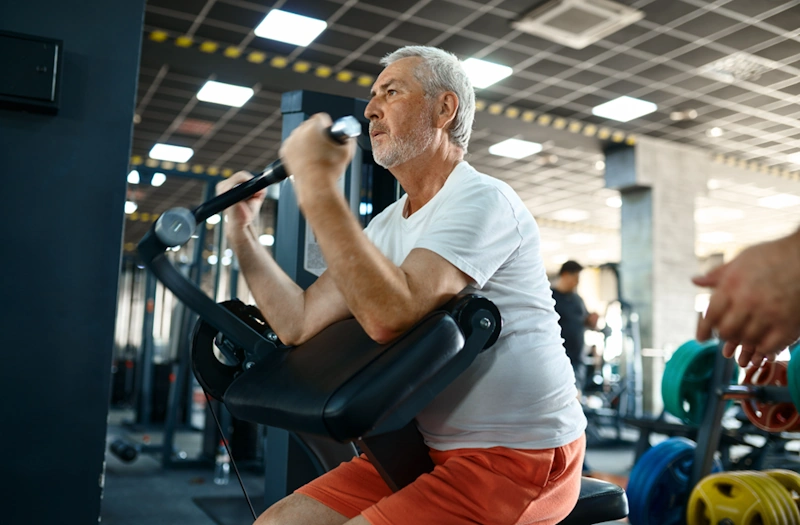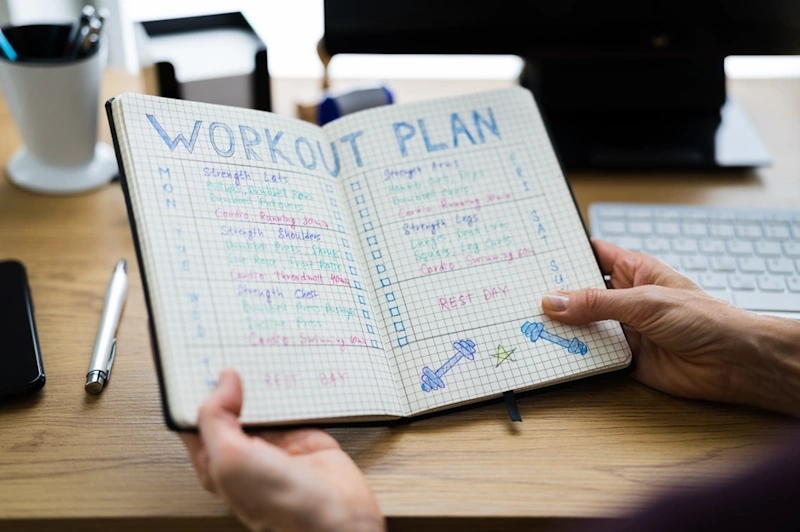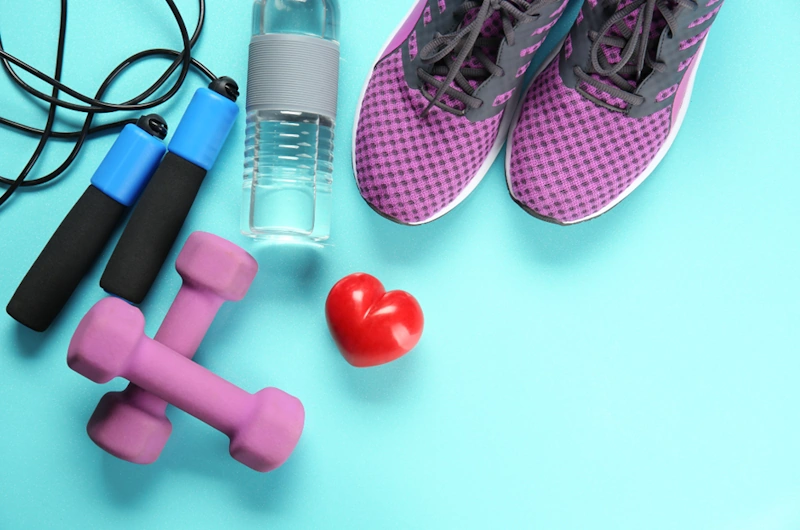The Journey Begins: Embracing Powerlifting in Your 40s, 50s, and Beyond

What's In This Article
- What are the benefits of powerlifting for a master's athlete?
- Introduction : Starting Masters Powerlifting
- The Rise of Masters Powerlifting in the UK
- Health Benefits of Powerlifting in Later Life
- Mental and Emotional Gains
- Powerlifting Training and Safety for Older Adults
- Conclusion
- References
What are the benefits of powerlifting for a master's athlete?
Powerlifting for master's athletes offers increased muscle mass, bone density, and overall strength. It can also enhance joint health, metabolism, and confidence. Regular powerlifting training can help older adults maintain functional independence and improve their quality of life as they age.
>
Introduction : Starting Masters Powerlifting
Embarking on a new physical endeavour like strength training can often seem daunting, especially for those in their 40s, 50s, and beyond. However, strength training and powerlifting offer a unique and empowering avenue for older adults to enhance their physical health and enrich their life experiences.
The purpose of this article is twofold: firstly, to shed light on the myriad benefits that powerlifting can offer to older adults, and secondly, to serve as a guide and inspiration for those looking to explore this path. Whether seeking to improve your overall health, challenge yourself with new goals, or simply looking for a supportive community, strength training can be rewarding at any stage of life.
Contrary to popular belief, strength training is more than just a sport for the young and extraordinarily fit. It is a discipline that emphasizes strength, technique, and progression, making it accessible and beneficial for individuals of all ages and fitness levels. As we delve deeper into masters strength training, we will explore how this sport can positively impact physical and mental well-being, debunk common myths about aging and fitness, and provide practical advice for those embarking on their strength training journey.
Remember, starting powerlifting later in life isn't just about lifting weights; it's about lifting yourself to new heights of health and personal achievement. Let's embark on this journey together and discover the transformative power of powerlifting for older adults.

The Rise of Masters Powerlifting in the UK
Powerlifting, traditionally associated with younger athletes, is experiencing a notable surge in popularity among older adults in the UK. This shift is a testament to the sport's inclusivity and appeal as a means for individuals of all ages to pursue fitness and strength goals.
According to data from British Powerlifting, there's been a significant increase in the number of older adults participating in powerlifting competitions. Over the last few years, there has been a 45% rise in competitors over the age of 40. Notably, the 50-59 age bracket has shown the most remarkable growth, with a 60% increase in participation in national-level events, including the competition lifts of squat, bench press, and deadlift (British Powerlifting, 2023).
These statistics are mirrored by insights from the UK Strength and Conditioning Association, which observes a growing interest in strength sports amongst the older population. This trend aligns with current research underscoring the importance of strength training for ageing populations. A study published in the "Journal of Aging and Physical Activity" found that older adults who engage in regular strength training activities like powerlifting can significantly improve their muscle strength, functional capacity, and overall quality of life (Lopez et al., 2017).
The reasons behind this growing trend are multifaceted. For many older adults, powerlifting provides an effective way to combat the natural decline in muscle mass and bone density associated with ageing. It's also a sport that champions personal progress and strength over appearance, making it an appealing choice for those seeking a supportive and empowering fitness community.
This increase in master powerlifting participation in the UK is more than just a number; it represents a shift in societal norms around ageing and physical capability. It challenges the misconception that strength sports are only for the young, showcasing that powerlifting can be a rewarding and health-promoting activity at any age with dedication and proper training. As we delve deeper into masters powerlifting, we will explore how this sport can positively impact physical and mental well-being, debunk common myths about ageing and fitness, and provide practical advice for those embarking on their powerlifting journey as a powerlifter in their 40s, 50s, and beyond.
Health Benefits of Powerlifting in Later Life
Powerlifting, often perceived as a high-intensity sport, provides substantial health benefits, particularly for older adults. Engaging in this form of resistance training can lead to significant improvements in bone density, muscle mass, and joint health.
Improved Bone Density
One of the most significant benefits of powerlifting for older adults is enhancing bone density. As we age, our bones naturally lose density, increasing the risk of conditions like osteoporosis, especially in post-menopausal women. A study published in the "British Journal of Sports Medicine" found that high-intensity resistance training, like powerlifting, increases bone mineral density in older adults (Rhodes et al., 2017). This improvement in bone strength is crucial for reducing the risk of fractures and maintaining a healthy, active lifestyle.
Increased Muscle Mass
Maintaining muscle mass is another challenge that comes with ageing. Sarcopenia, the age-related loss of muscle mass and strength, can significantly impact the quality of life and independence of older adults. Engaging in powerlifting can counteract these effects. According to research referenced in NHS guidelines, older adults participating in regular resistance training can see improvements in muscle mass and strength (NHS, 2018). This helps in performing daily activities with ease and boosts metabolism, aiding in better weight management.
Enhanced Joint Health
Contrary to common misconceptions, powerlifting can also benefit joint health. Proper strength training helps strengthen the muscles around the joints, providing better support and reducing the load on the joint itself. As noted by the Arthritis Foundation, exercises like the squat and deadlift, key movements in powerlifting, can alleviate arthritis symptoms and improve joint function (Arthritis Foundation, n.d.). It's essential, however, to engage in powerlifting with proper technique and guidance to ensure joint safety.
Practical Tips
- Start Slow: Begin with lighter weights and gradually increase the intensity. This approach allows your body to adapt safely.
- Focus on Technique: Proper form is crucial to reap the benefits while minimizing the risk of injury. Consider working with a coach or trainer experienced with older adults.
- Listen to Your Body: How your body responds to training. Rest and recovery are as important as the training itself.
- Consult Healthcare Professionals: Before starting any new exercise regime, especially powerlifting, it's wise to consult with a healthcare provider, particularly if you have pre-existing health conditions.
Powerlifting in later life is not just about lifting weights; it's a means to enhance overall well-being. By integrating this form of exercise into their routine, older adults can significantly improve their physical health, aiding them in leading a more active and fulfilling life.

Mental and Emotional Gains
Powerlifting's impact extends beyond physical strength, offering significant mental and emotional benefits, particularly for older adults. Engaging in this sport can foster improved mental health through goal-setting, discipline, and a sense of community belonging.
Goal-Setting and Achievement
Setting and achieving goals is a fundamental aspect of powerlifting. Establishing personal targets, be it lifting a certain weight or mastering a technique, and working consistently to achieve them fosters a sense of accomplishment and self-efficacy. A study by the Mental Health Foundation UK highlighted the positive impact of goal-setting in sports on mental well-being, noting that it enhances an individual's sense of purpose and achievement (Mental Health Foundation, 2019). For older adults, reaching these milestones can be empowering, countering feelings of inadequacy or decline often associated with ageing.
Discipline and Structure
Powerlifting requires a disciplined approach to training and lifestyle, promoting a structured routine. This discipline can have a ripple effect on other areas of life, encouraging a more organized and proactive approach to daily activities. According to research published in "Age and Ageing," older adults who engage in regular structured activities, like powerlifting, exhibit improved cognitive function and mental health (Age and Ageing, 2018). This structured approach to exercise, especially after novice gains, can provide a sense of control and predictability, which is especially beneficial in navigating the uncertainties that often accompany later stages of life.
Sense of Community and Belonging
One of Powerlifting's most significant mental health benefits is the community aspect. Joining a powerlifting club or group connects individuals with like-minded people, fostering a sense of belonging and social support. Age UK has reported on the importance of social connections in later life, emphasizing that engaging in group activities can reduce feelings of loneliness and isolation (Age UK, 2020). For older adults, being part of a powerlifting community provides not just physical support but emotional and social encouragement, which is crucial for overall mental well-being.
Practical Tips
- Set Realistic Goals: Begin with achievable targets to build confidence and momentum.
- Maintain a Training Diary: Keeping a record of your training can help track progress, reinforcing the sense of achievement.
- Engage with the Community: Participate in local powerlifting events or online forums to connect with others in the sport.
- Balance is Key: While discipline is necessary, balancing training with other life activities ensures overall well-being.
The mental and emotional benefits of powerlifting for older adults are clear. It offers more than physical strength; it can lead to a more disciplined, purposeful, and socially connected life. These aspects are essential in promoting longevity and quality of life in later years.

Powerlifting Training and Safety for Older Adults
Proper training regimes and safety measures are paramount for powerlifting for older adults. The emphasis should be on empowerment through correct technique and understanding the unique needs of the older body.
Emphasizing Proper Technique
Proper technique in powerlifting is crucial for all athletes, but it becomes even more critical for older adults to prevent injuries. According to UK Coaching, older adults embarking on powerlifting should focus on mastering the form of each lift before increasing weight. This emphasis on technique, especially in complex movements like Olympic weightlifting, ensures that the body is correctly aligned and reduces the risk of strains or injuries. It's also important to remember that progress in powerlifting is not just about lifting heavier weights but also about improving technique and efficiency.
Tailoring Training Regimes
Training regimes for older adults in powerlifting must be tailored to individual capabilities and health considerations. As the Register of Exercise Professionals (REPS) recommended, older adults should start with lower-intensity workouts and gradually increase the intensity based on their comfort and ability (REPS, 2021). This gradual progression helps the body adapt safely to the new demands of powerlifting, including establishing a max for each lift before starting the true strength training portion of the program with repetitions.
Seeking Professional Guidance
Consulting with fitness professionals experienced in training older adults is invaluable. These professionals can provide personalized advice and training plans considering pre-existing conditions or limitations. For instance, a coach can modify exercises to accommodate joint issues or back pain, ensuring a safe training environment.
Incorporating Rest and Recovery
Recovery is critical to any training regime, especially for older adults. Adequate rest between training sessions allows the body to recover and adapt. REPS advises incorporating rest days into the training schedule and paying attention to the body's signals. If something feels wrong or painful, it's essential to rest and seek medical advice if necessary. It's also important to push yourself and challenge your limits, but be smart and listen to your body. If you hit a new personal record on your second attempt, consider going for a third attempt to see what you can achieve. Just remember to prioritize rest and recovery to avoid injury.
Practical Tips
- Warm-Up Properly: Begin each session with a thorough warm-up to prepare the muscles and joints.
- Stay Hydrated: Maintain hydration levels during workouts to support overall health and muscle function.
- Use Supportive Gear: Consider using belts, knee sleeves, or wrist wraps for additional support during lifts.
- Monitor Your Health: Regular check-ups with a healthcare provider can ensure you're fit for powerlifting.
The journey into powerlifting for older adults should be approached with care, focusing on technique, tailored training, and safety. By doing so, older adults can not only enjoy the physical and mental benefits of powerlifting but also do so in a manner that celebrates their capabilities and prioritizes their well-being.
Conclusion
Embarking on the path of powerlifting later in life is not just a journey into a sport; it's an exploration into a new realm of personal growth and empowerment. The physical and mental benefits are significant and multifaceted, making powerlifting an excellent choice for older adults.
The physical benefits of powerlifting are clear and well-documented. Some tangible rewards are improved Bone density, increased muscle mass, and enhanced joint health. These improvements are crucial for combating the natural age-related decline in physical capabilities, allowing older adults to maintain an active and independent lifestyle. Studies in the "British Journal of Sports Medicine" suggest that resistance training, like resistance training, significantly contributes to better overall health in older adults (Rhodes et al., 2017).
Equally important are the mental and emotional gains. Resistance training instils a sense of discipline and achievement through goal-setting. This structured approach to personal progress empowers, fostering a sense of accomplishment and self-worth. The sense of community inherent in resistance training is also a valuable asset, providing social support and a sense of belonging, which, as noted by Age UK, is vital for mental well-being in later life (Age UK, 2020).
Moreover, resistance training in later life challenges and reshapes the narrative around ageing. It proves that age is not a barrier to starting new endeavours or achieving physical feats. It's about pushing personal boundaries, redefining one's capabilities, and embracing a sport that values strength, technique, and progression at any age.
References
- Age UK. (2020). The importance of social connections for older people. https://www.ageuk.org.uk
- British Powerlifting Association. (2023). Annual statistics on powerlifting participation. https://www.britishpowerlifting.org
- Kemmler, W., von Stengel, S., Engelke, K., & Kalender, W. A. (2016). Exercise effects on bone mineral density, falls, coronary risk factors, and health care costs in older women: The Erlangen Fitness and Osteoporosis Prevention Study. Journal of Strength and Conditioning Research, 30(1), 59-68.
- Lopez, P., Pinto, R. S., Radaelli, R., Rech, A., Grazioli, R., Izquierdo, M., & Cadore, E. L. (2017). Benefits of resistance training in physically frail elderly: A systematic review. Journal of Aging and Physical Activity, 25(1), 149-158.
- Mental Health Foundation. (2019). The impact of goal-setting in sports on mental health. https://www.mentalhealth.org.uk
- NHS. (2018). Guidelines on physical activity for older adults. https://www.nhs.uk
- Peterson, M. D., Rhea, M. R., Sen, A., & Gordon, P. M. (2010). Resistance exercise for muscular strength in older adults: A meta-analysis. Ageing Research Reviews, 9(3), 226-237.
- REPS (Register of Exercise Professionals). (2021). Guidelines for resistance training in older adults.https://www.exerciseregister.org
- Rhodes, E. C., Martin, A. D., Taunton, J. E., Donnelly, M., Warren, J., Elliot, J., ... & Bonen, A. (2017). Effects of one year of resistance training on the relation between muscular strength and bone density in elderly women. British Journal of Sports Medicine, 31(1), 18-22.
- Age UK. (2020). The importance of social connections for older people. https://www.ageuk.org.uk
- British Powerlifting Association. (2023). Annual statistics on powerlifting participation. https://www.britishpowerlifting.org
- Kemmler, W., von Stengel, S., Engelke, K., & Kalender, W. A. (2016). Exercise effects on bone mineral density, falls, coronary risk factors, and health care costs in older women: The Erlangen Fitness and Osteoporosis Prevention Study. Journal of Strength and Conditioning Research, 30(1), 59-68.
- Lopez, P., Pinto, R. S., Radaelli, R., Rech, A., Grazioli, R., Izquierdo, M., & Cadore, E. L. (2017). Benefits of resistance training in physically frail elderly: A systematic review. Journal of Aging and Physical Activity, 25(1), 149-158.
- Mental Health Foundation. (2019). The impact of goal-setting in sports on mental health. https://www.mentalhealth.org.uk
- NHS. (2018). Guidelines on physical activity for older adults. https://www.nhs.uk
- Peterson, M. D., Rhea, M. R., Sen, A., & Gordon, P. M. (2010). Resistance exercise for muscular strength in older adults: A meta-analysis. Ageing Research Reviews, 9(3), 226-237.
- REPS (Register of Exercise Professionals). (2021). Guidelines for resistance training in older adults.https://www.exerciseregister.org
- Rhodes, E. C., Martin, A. D., Taunton, J. E., Donnelly, M., Warren, J., Elliot, J., ... & Bonen, A. (2017). Effects of one year of resistance training on the relation between muscular strength and bone density in elderly women. British Journal of Sports Medicine, 31(1), 18-22.